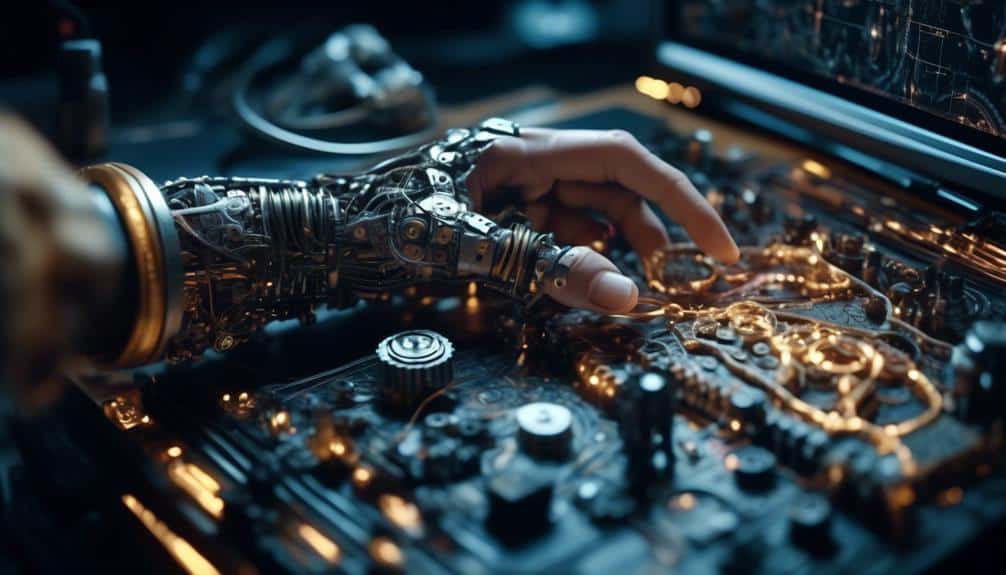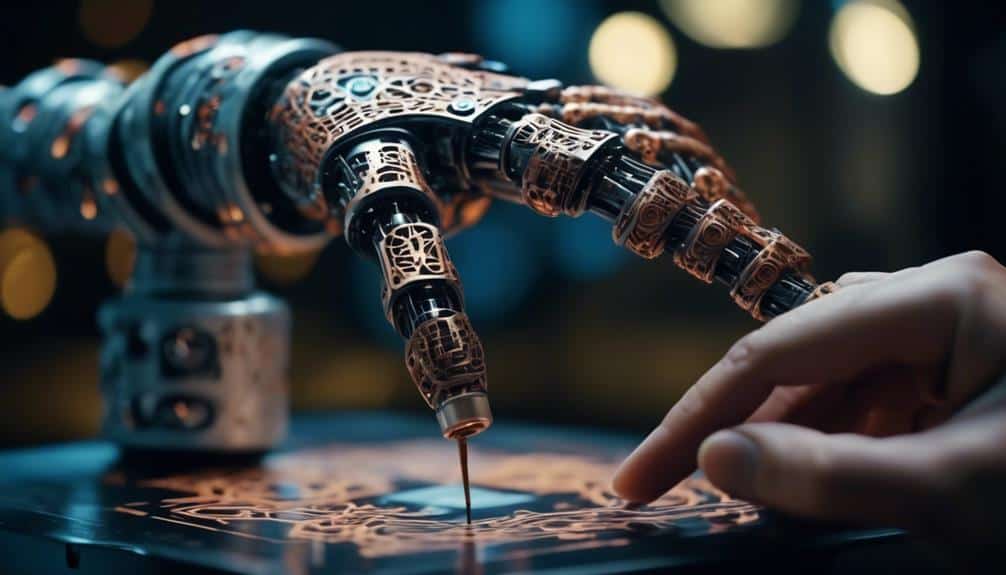Blending Human Creativity With Machine Efficiency
In a world where the line between human ingenuity and machine precision blurs more each day, one might chuckle at the irony of the quest to blend human creativity with machine efficiency.
The idea sounds almost like a sci-fi plot, but the implications are very real and relevant to the way businesses operate today.
As you navigate through the complexities of this evolving landscape, you'll find yourself pondering the endless possibilities that arise when minds and algorithms converge on a quest for optimal productivity.
Key Takeaways
- Collaboration between humans and machines leads to innovative solutions beyond individual capabilities
- Automation of tasks allows for more time for creative problem-solving and innovation
- Data analytics provide strategic insights essential for informed decision-making
- Overcoming resistance to change is crucial for successful integration of human creativity and machine efficiency
The Importance of Collaboration

Collaboration plays a pivotal role in seamlessly merging human creativity with machine efficiency, fostering innovation and productivity in today's dynamic work environment. Creative partnerships thrive on the synergy between the human touch and machine precision, leading to the development of collaborative solutions that surpass individual capabilities. When coworkers come together, combining their diverse backgrounds and skill sets, they create a melting pot of ideas that can be refined and implemented efficiently with the help of technology.
Through collaborative efforts, teams can tackle complex problems from multiple angles, leveraging the unique strengths of each member to achieve optimal results. This blend of human ingenuity and technological prowess enables organizations to adapt quickly to changing market demands and stay ahead of the competition. By fostering a culture of collaboration, companies empower their employees to think innovatively, work cohesively, and drive impactful change within their respective industries. Ultimately, embracing creative partnerships and collaborative solutions leads to a more efficient, effective, and forward-thinking work environment.
Enhancing Innovation Through Automation
Innovating through automation streamlines processes, accelerates development, and drives competitive advantage in today's fast-paced business landscape. When enhancing innovation through automation, you unlock a plethora of possibilities that can revolutionize your approach to creativity and efficiency.
- Creativity Automation: Automating repetitive tasks frees up valuable time for your team to focus on creative problem-solving and ideation.
- Innovation Efficiency: By integrating automation into your innovation processes, you can reduce time-to-market for new ideas and products, staying ahead of the competition.
- Human-Machine Collaboration: Embrace the power of collaboration between humans and machines to amplify the impact of your innovative initiatives, combining the best of both worlds for optimal results.
Through automated ideation and streamlined workflows, you pave the way for a more agile and responsive innovation ecosystem, where creativity flourishes, and efficiency reigns supreme. Embrace automation as a catalyst for innovation and watch your organization soar to new heights of success.
Leveraging Data for Strategic Insights

Leveraging data analytics provides invaluable strategic insights essential for informed decision-making and competitive advantage in today's data-driven business landscape. Data-driven decision making involves collecting and analyzing vast amounts of data to uncover patterns, trends, and valuable insights that can guide strategic analysis. By harnessing the power of data, organizations can make informed decisions that drive growth, optimize processes, and stay ahead of the competition.
Strategic analysis fueled by data allows businesses to identify opportunities, mitigate risks, and allocate resources effectively. Through advanced analytics tools and technologies, companies can delve deep into their data to extract meaningful insights that inform their strategic direction. By leveraging data for strategic insights, organizations can improve operational efficiency, enhance customer experiences, and foster innovation.
Overcoming Resistance to Change
Resistance to change can present a formidable challenge for organizations seeking to adapt and evolve in today's dynamic business environment. When addressing this resistance, it's crucial to implement effective change management strategies and cultivate a supportive organizational culture. Here are key points to consider:
- Change Management: Utilize structured approaches to guide individuals and teams through the transformation process. Implement clear communication channels, provide training, and offer support to facilitate a smoother transition.
- Organizational Culture: Foster an environment that values flexibility, learning, and open-mindedness. Encourage collaboration and feedback to create a culture that embraces change as a natural part of growth.
- Innovation Adoption: Promote the benefits of innovation and highlight success stories to inspire confidence in new initiatives. Encourage experimentation and recognize and reward employees who contribute to innovative solutions.
Improving Decision-Making Processes

To enhance organizational adaptability and effectiveness, optimizing decision-making processes is paramount in ensuring sustainable growth and success. In today's rapidly changing business landscape, leveraging cognitive computing and algorithmic decision-making can significantly enhance your organization's ability to make informed decisions efficiently.
Cognitive computing empowers decision-making by mimicking human thought processes through data analysis, pattern recognition, and natural language processing. By utilizing cognitive computing technologies, you can augment your decision-making capabilities with advanced analytics and predictive modeling, enabling you to extract valuable insights from vast amounts of data.
Algorithmic decision-making involves the use of mathematical algorithms to automate decision processes based on predefined rules and parameters. By embracing algorithmic decision-making tools, you can streamline routine decisions, reduce biases, and improve the consistency and accuracy of your decision-making processes.
Integrating cognitive computing and algorithmic decision-making into your organizational workflow can enhance your decision-making processes, drive innovation, and ultimately lead to better outcomes for your business and stakeholders. Embracing these technologies will enable you to navigate complexity with confidence and achieve sustainable success in today's dynamic environment.
Achieving Scalability and Consistency
To achieve scalability and consistency, consider implementing automation to streamline processes and handle increasing workloads efficiently.
Integrate AI technologies to ensure that tasks are completed consistently and with a high level of accuracy.
Scalability Through Automation
Incorporating automated processes into your workflow can significantly enhance scalability and ensure consistency in your operations. By automating tasks, you can streamline processes, leading to increased productivity and efficiency. This not only frees up time for more strategic endeavors but also reduces the likelihood of human error, ensuring a higher level of consistency in your output. Additionally, automation allows you to scale your operations more easily, adapting to increased demands without overwhelming your resources.
Embracing automation tools empowers you to handle growth smoothly and maintain a standard of quality across all facets of your business.
- Streamline processes for increased efficiency
- Reduce human error and ensure consistency
- Scale operations seamlessly to meet growing demands
Consistency With AI Integration
Integrating AI into your operations enhances scalability and consistency, revolutionizing the way you manage and grow your business. By maintaining human oversight while leveraging the power of AI, you can ensure that ethical considerations are prioritized in decision-making processes. Implementing machine learning ethics frameworks within your AI systems guarantees that they align with your values and comply with regulations. This harmonious blend of human judgment and machine efficiency not only drives consistency in your operations but also instills trust among your customers and stakeholders. Striking the right balance between human intervention and AI automation is key to achieving sustainable growth and maintaining a competitive edge in today's dynamic business landscape.
| Benefits of AI Integration | Enhanced Scalability | Improved Consistency |
|---|---|---|
| Efficiency | Increases capacity | Ensures uniformity |
| Accuracy | Streamlines processes | Reduces errors |
| Innovation | Facilitates growth | Standardizes outcomes |
Ensuring Ethical and Responsible AI

When implementing AI systems, it's crucial to prioritize ethical considerations and ensure that they align with responsible practices.
Ethical AI development involves creating algorithms that respect privacy, fairness, and transparency.
Responsible AI implementation requires ongoing monitoring and adjustments to mitigate potential biases and ensure the technology serves the greater good.
Ethical AI Development
To ensure the ethical and responsible development of AI, meticulous consideration of potential biases must be an integral part of the process. When developing AI systems, remember these key points:
- Ethical AI Bias: Identify and address any biases present in the data or algorithms used to prevent discriminatory outcomes.
- Transparency in Development: Maintain transparency throughout the AI development process to foster trust and accountability.
- Continuous Ethical Evaluation: Regularly evaluate AI systems to ensure they align with ethical standards and societal values.
Responsible AI Implementation
Maintaining ethical and responsible AI development practices requires a seamless alignment of meticulous bias identification with proactive measures during the implementation phase. When considering ethical considerations in AI implementation, it is crucial to address potential biases embedded in algorithms that might perpetuate discrimination. Implementation challenges may arise from balancing innovation with ethical standards, emphasizing the need for continuous monitoring and evaluation. Here's a table to elucidate the key aspects of responsible AI implementation:
| Ethical Considerations | Implementation Challenges |
|---|---|
| Fairness and transparency | Data privacy and security |
| Accountability and oversight | Interpretability of AI decisions |
| Diversity and inclusivity | Regulatory compliance |
| Bias mitigation strategies | Ethical decision-making frameworks |
Frequently Asked Questions
How Can Organizations Effectively Measure the Impact of Blending Human Creativity With Machine Efficiency?
To effectively measure the impact of blending human creativity with machine efficiency, consider crafting performance metrics that assess both individual and collaborative outcomes. Enhance team dynamics by fostering open communication and encouraging innovative collaboration strategies.
What Are Some Common Challenges Faced When Integrating Human Creativity and Machine Efficiency in the Workplace?
Navigating workplace dynamics can be tricky when blending human creativity with machine efficiency. Communication challenges often arise, hindering team collaboration. To overcome, prioritize clear communication and foster innovation strategies that leverage both human ingenuity and machine capabilities.
Can You Provide Examples of Industries or Companies That Have Successfully Implemented a Blend of Human Creativity and Machine Efficiency?
Innovative collaborations between creative thinkers and advanced automation have led to industry advancements. Successful case studies include tech giants like Google and creative agencies like IDEO, showing how human creativity and machine efficiency can harmoniously coexist.
How Can Individuals Enhance Their Creativity and Skillsets to Effectively Collaborate With Machines in a Work Setting?
To enhance collaboration with machines, focus on skill development. Embrace continuous learning, adapt to new technologies, and foster creativity. Cultivate a mindset that values teamwork, innovation, and efficiency. Stay curious, open-minded, and proactive in evolving work environments.
What Are Some Potential Future Trends or Developments in the Field of Blending Human Creativity With Machine Efficiency?
As you explore potential future trends, consider ethical considerations and future applications in blending human creativity with machine efficiency. Embrace collaborative tools and automation advancements to enhance productivity and innovation in the evolving work landscape.
Conclusion
In conclusion, blending human creativity with machine efficiency is essential for organizations to stay competitive in today's rapidly evolving landscape.
By fostering collaboration, enhancing innovation through automation, leveraging data strategically, overcoming resistance to change, improving decision-making processes, achieving scalability and consistency, and ensuring ethical AI practices, businesses can unleash the full potential of human-machine partnerships.
Embracing this blend won't only drive efficiency and productivity but also pave the way for groundbreaking advancements and sustainable growth.








